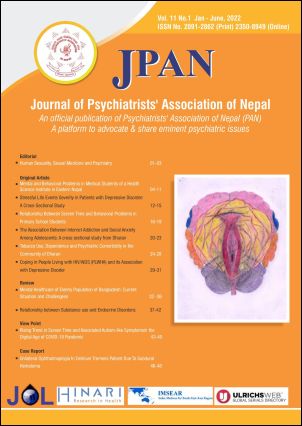Relationship Between Screen Time and Behavioral Problems in Primary School Students
DOI:
https://doi.org/10.3126/jpan.v11i1.53810Keywords:
Screen time, Behaviour problem, Children, Primary school, NepalAbstract
Introduction: Rampant use of electronic based devices like television, mobile phones, gaming consoles, computers, etc. disregarding the beneficial effects of physical activity, social interaction, sleep and academic performance result in deficit of psychological well-being of children. The aim of our study was about screen use in Nepalese children and the relationship of screen time with behavioral problems in primary school students. In this study we collected important information based on our objectives on primary school students in our context and to avail the information to clinicians, parents, guardians, educators, policy makers and all those involved.
Methodology: This study was done in Budhanilkantha municipality of Kathmandu district, Nepal. One community school and one private school were randomly selected from a list of schools. Data was collected from all primary school students of these schools with the help of questionnaires filled by parents. Screen _me and different socio demographic factors that might affect screen time was assessed with the help of questionnaires filled by parents. Behavioral problems were assessed using parent-filled Strength and Difficulties Questionnaire. Statistical analysis was done using SPSS version 24 for windows.
Result: Our study sample contained 314 primary school students. 52.5% of them were from private school and 47.5% from community school. The mean daily screen time was 1.96 hours, and more than one-fourth of the students had daily screen time of more than two hours per day. Higher number of televisions in the house, presence of computer in the house, more frequent screen use while having meals, higher frequency of screen use with parents, having father with university degree were the factors having statistically significant association with higher screen time of children. Students with daily screen time of more than two hours per day had higher internalizing problem score (8.93±3.453), higher externalizing problem score (9.28±3.885) and total problem score (18.21±6.253) compared to those with screen time of two hours or less (6.97±3.285, 6.10±3.398, 13.07±5.402 respectively). The difference between the groups were statistically significant on all three scales on Mann Whitney U-test (p<0.001, p<0.001, p<0.001 for internalizing, externalizing and total problem score respectively).
Conclusion: The higher screen time in children was significantly associated with higher behavioral problems. Our study findings re-emphasized the need to follow the guidelines and recommendations set by international regulatory bodies as well as develop guidelines on our own on limiting screen time in children for betterment of psychological wellbeing of children.
Downloads
Downloads
Published
How to Cite
Issue
Section
License
Copyright (c) 2022 Journal of Psychiatrists' Association of Nepal

This work is licensed under a Creative Commons Attribution 4.0 International License.
This license enables reusers to distribute, remix, adapt, and build upon the material in any medium or format, so long as attribution is given to the creator. The license allows for commercial use.




